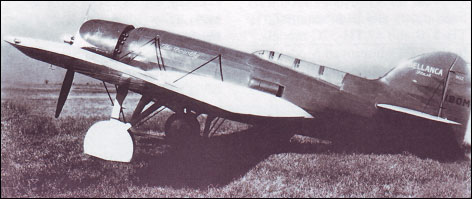|
| The Model 28 took two forms, the first being the Model 28-70 built as a two-seat racing aircraft, slightly less powerful than the rebuilt Model
28-90. The Model 28-70 was designed to compete in the 1934 MacRobertson Air Race from Britain to Australia, but following
a rebuild as the 28-90 it made a record transatlantic crossing in 1936, piloted by lames Mollison. Military development of the 28-90 (also known as Flash) proceeded with France ordering 10 as communications types. These were earmarked for the Republican side in the Spanish Civil War and delivery was stopped. The Model 28-110 was ordered by the Chinese Government in 1937.
| MODEL | Model 28-110 |
| ENGINE | 1 x 1050hp Pratt & Whitney R-1830-S3C3G Twin Wasp radial engine |
| WEIGHTS |
| Take-off weight | 3835 kg | 8455 lb |
| DIMENSIONS |
| Wingspan | 14.65 m | 48 ft 1 in |
| Length | 7.90 m | 26 ft 11 in |
| Height | 2.64 m | 9 ft 8 in |
| PERFORMANCE |
| Max. speed | 467 km/h | 290 mph |
| Ceiling | 10670 m | 35000 ft |
| Range | 1287 km | 800 miles |
| ARMAMENT | 5 x 7.62mm machine guns, 725kg of bombs |
| Dennis Baer, e-mail, 02.04.2012 16:05 Mr. Schwarz, if I have researched the history correctly, your father was not just crew chief, he was also the project manager for the construction of the 28-70. I believe he had Albert Mooney (later of Mooney Aircraft fame) working as his junior engineer for the project. There is an informal ongoing search for any fragments of any of the 28-90 /28-110 aircraft. Did your dad ever mention where any bits and pieces might have ended up? reply | | Henry Schwarz, Jr., e-mail, 13.02.2012 03:41 I do believe that this aircraft was originally known as the Irish Swoop and was built for the London to Melbourne race. However the Limeys disqualified the plane because it could carry too much fuel and would kick their little butts by making fewer fueling stops than the British Comet which won the race. My father was the crew chief for Bellanca's racers. reply |
|
Do you have any comments?
|
| 
COMPANY
PROFILE
All the World's Rotorcraft
|






